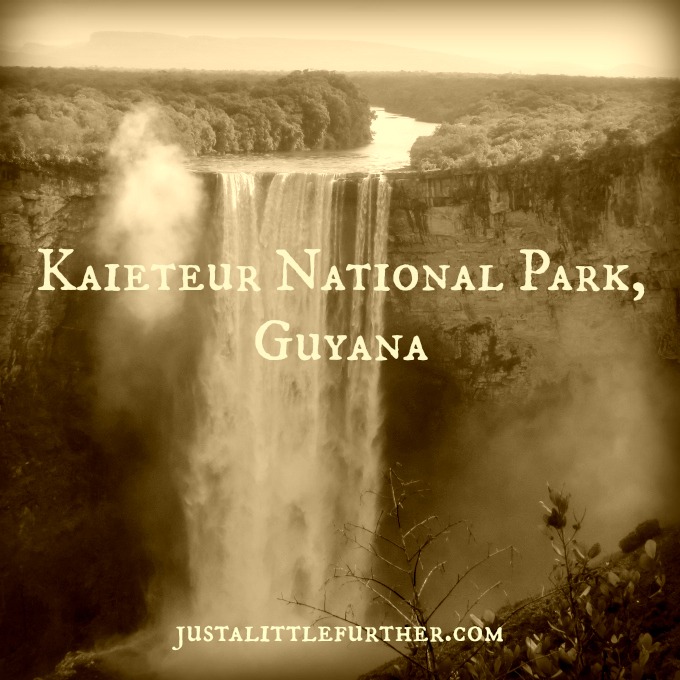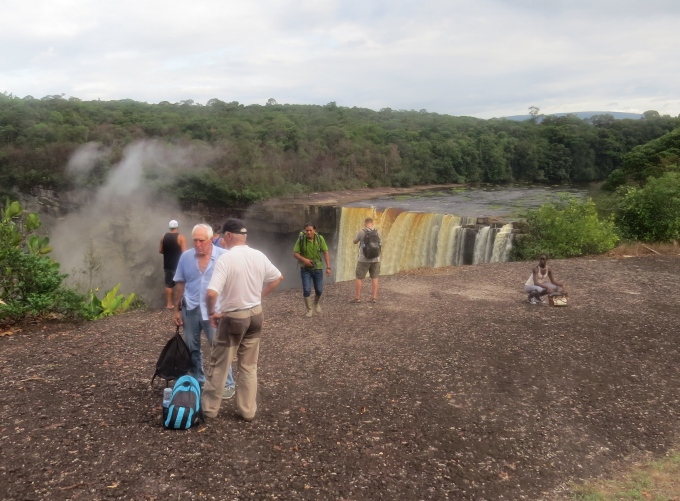 Described as the world's widest, single drop waterfall, Kaieteur is considered a must-see while in Guyana. Located on the Potaro River in the Amazon rain forest, its cascade plunges 226m (741ft) in a single drop and a total of 251m (815ft) before reaching the gorge below. That's about five times higher than Niagara Falls and more than twice the height of Victoria Falls. According to the World Waterfall Database, the average volume of water flowing over the falls is somewhere around 23,000 cubic feet per second, making this a rare combination of a very tall waterfall on a high volume river.
Described as the world's widest, single drop waterfall, Kaieteur is considered a must-see while in Guyana. Located on the Potaro River in the Amazon rain forest, its cascade plunges 226m (741ft) in a single drop and a total of 251m (815ft) before reaching the gorge below. That's about five times higher than Niagara Falls and more than twice the height of Victoria Falls. According to the World Waterfall Database, the average volume of water flowing over the falls is somewhere around 23,000 cubic feet per second, making this a rare combination of a very tall waterfall on a high volume river.

Gem drove us to Ogle Airport in Georgetown, an airport used expressly by tour planes. Along with the pilot and 10 other passengers, we crammed into the tiny, single prop Grand Caravan C208B plane for a one hour flight to Kaieteur. It wasn't the safest looking plane. The pilot mumbled something about seat belts, revved up, and we were airborne. No peanuts … no beverage service.

We took off right on time, without incident (the best kind of take-off). The views from the plane were excellent until the clouds moved in. Once away from the city, David remarked that the rain forest, when we could see it, looked like broccoli florets.

We landed on a tiny airstrip at the national park headquarters where two AmerIndian guides, Max and Omar, were waiting for us, ready to whisk us away on a 90-minute hike through the rain forest to the falls.


We struck out immediately for Kaieteur with Max in the lead. We stopped quite frequently to observe and learn more about some of the unusual, endemic plants and animals in the area. The red drosera kaieteurensis (yes, Max knew all the Latin names), a member of the sundew family, is a carnivore, that invites insects to dinner, luring them with its bright color and sweet, sticky sap, then gobbling them up.

We also learned a little about the history and legends associated with Kaieteur. Charles Barrington Brown, a British geologist, was the first European to see the falls and record its location in 1870. AmerIndian legends concerning the falls abound, but Max told us this one. Kaie was an old Patamona chief who sacrificed himself to the great spirit, Makonaima, by paddling over the falls in his canoe in order to save his people and bring peace between them and neighboring tribes. “Teur” is the AmerIndian word for falls, hence the name Kaieteur. It's also referred to as Old Man Falls. A stone formation at the edge of the falls is said to be the face of Kaie.

There were three separate trails which took us to different views of the falls. The first trail was quite straightforward, except for the labbaria (fer de lance) snake that was curled up against a stepping stone in a narrow part of the trail. Max watched as we all carefully passed, avoiding the snake as best we could. They're said to have grumpy dispositions. Their venom is particularly lethal and fast acting although treatment is usually possible if the victim receives medical attention soon enough. Hmmm … how far were we from Georgetown? The guides took it all in stride.

We could hear the thunder of the falls and feel the vibration before we saw them.

The second viewpoint was a bit more strenuous to get to. We went over a narrow moss-covered plank bridge, ducked down under huge boulders, around massive tree roots, through dense foliage and finally up a steep, muddy incline before reaching our destination. It was well worth the effort.


Along the trail we saw huge bromeliads (Brocchina micrantha); some were 8-10' (2-3m) tall. Within the tanks (axis of the leaves) of these giants live rare, tiny golden frogs (Anomaloglossus beebei). The frog is born, lives and dies here and in all the world, is only found on the Kaieteur Plateau. Indigenous people once collected poison from the slime that oozes from the frog's skin and used the toxin on blowgun darts and arrows. The curare-like toxin is said to be 160,000 times more powerful than cocaine and kills nearly instantly. Omar pointed one out to us. It was so tiny, it was difficult to see as it peeked out at us. Unfortunately, with 11 other people waiting to see it, we were rushed (I hate that!) and the photo opp was only seconds long per person before we were rushed along to another viewing point.

We reached the third viewpoint on an easy trail which opened to a wide, level area from which to view the falls. Signs cautioned us to stay at least 8' from the edge since there are no rails, but most folks ignored the caution, as did the guides. It wasn't until after our visit that we realized we had only seen three lookouts and not the four that are usually on the tour. It appears there have been two suicides in recent months by young girls leaping from the edge.
 All too soon, it was time to head back to the park headquarters. Cold water and plantain chips were waiting for us and then we re-boarded our tiny plane to head back to Georgetown. On the return, the visibility was much improved. The pilot flew over the falls providing us with a good aerial view.
All too soon, it was time to head back to the park headquarters. Cold water and plantain chips were waiting for us and then we re-boarded our tiny plane to head back to Georgetown. On the return, the visibility was much improved. The pilot flew over the falls providing us with a good aerial view.

We could see a network of brown rivers snaking their way through the dense jungle below. Every once in awhile a mining settlement popped into view, an unsightly blotch in the greenery below.

We caught sight of the Demarara as it meandered its way toward Georgetown.

Several Georgetown landmarks came into view including Stabroek Market, the Demarara Harbour Bridge and the Georgetown Lighthouse.

Before we knew it, we were landing at Ogle Airport once more.

Gem and Kit met us and whisked us off to the brand new Giftland Mall, Guyana's first mall and quite a novelty. The mall was bright and shiny and all decked out for Christmas. A local comic, Jumbie Jones introduced local entertainment, Guyana's Prime Minister gave a short speech and then the moment we'd all been waiting for … the lighting of the Christmas tree.

A very, very full and memorable day and by the time Kit and Gem dropped us off, we were too tuckered to go out for dinner. We had a “picnic” of crackers, cheese and apples (and a little wine) in the room and prepared to head back to Bartica in the morning.



 Described as the world's widest, single drop waterfall, Kaieteur is considered a must-see while in Guyana. Located on the Potaro River in the Amazon rain forest, its cascade plunges 226m (741ft) in a single drop and a total of 251m (815ft) before reaching the gorge below. That's about five times higher than Niagara Falls and more than twice the height of Victoria Falls.
Described as the world's widest, single drop waterfall, Kaieteur is considered a must-see while in Guyana. Located on the Potaro River in the Amazon rain forest, its cascade plunges 226m (741ft) in a single drop and a total of 251m (815ft) before reaching the gorge below. That's about five times higher than Niagara Falls and more than twice the height of Victoria Falls. 











 All too soon, it was time to head back to the park headquarters. Cold water and plantain chips were waiting for us and then we re-boarded our tiny plane to head back to Georgetown. On the return, the visibility was much improved. The pilot flew over the falls providing us with a good aerial view.
All too soon, it was time to head back to the park headquarters. Cold water and plantain chips were waiting for us and then we re-boarded our tiny plane to head back to Georgetown. On the return, the visibility was much improved. The pilot flew over the falls providing us with a good aerial view.




